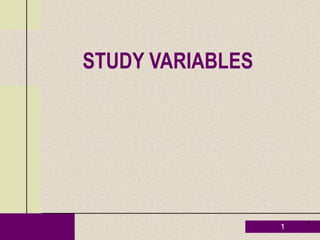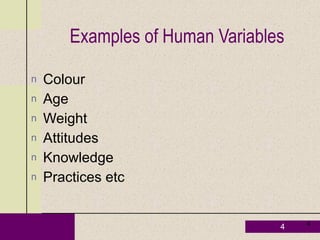Study Variables (3).pdfStudy Variables (3).pdf
- 2. !2 2 Outline n What are variables? n What are the different types of variables? n Distinguish between dependent and independent variables
- 3. !3 3 Variables n A variable is the characteristic (of a person, object or phenomenon) that can take on different values n It may change (as opposed to Constants) in the same person at different times or it varies from person to person at the same time n It is the data needed to meet the objectives of the study
- 4. !4 4 Examples of Human Variables n Colour n Age n Weight n Attitudes n Knowledge n Practices etc
- 5. !5 5 Examples of Health Unit Variables n Location n Bed capacity n Number of staff n Bed occupancy
- 6. !6 6 Variables in Research n Are the factors under study
- 7. !7 7 Where do we get variables from? n Are (should be) contained in the objectives n Are derived from the problem analysis diagram – The factors assumed to cause or influence the problem n May also be derived from topic
- 8. !8 8
- 9. !9 9 Variables Variables nWaiting time nAvailability of drugs nFrequency of supervision
- 10. !10 10 n To determine the socioeconomic factors that influence teenage in.. n To identify socio-demographic factors… Variables from Objectives
- 11. !11 11 Variables from Objectives n To assess household knowledge, attitudes and practices towards fever in children n To establish the quality of services rendered to the patients n To find out the measures in place for occupatio²€health and safety at Kajjansi Clays Factory
- 12. !12 12 Variables from Objectives n To establish the types of waste produced at each of the hospitals n To describe the health care infrastructure per district with respect to maternal health care
- 13. !13 13 Operationalising Variables n Variables may be confusing unless they are operationalised n They may have many interpretations n Operationalising variables means making them distinct and measurable – Give each variable an operational definition
- 14. !14 14 Operationalising Variables n The values of some variables can easily be determined, e.g. – Age: 2months., 3 years, young, old, etc – Sex: male, female: Sex= Female n The values of some other variables may not be measured directly, e.g. – Level of knowledge, nutritional status
- 15. !15 15 INDEPENDENT AND DEPENDENT VARIABLES n Independent Variables: – Used to measure or describe the factors presumed to cause or influence the development of the problem – Controlled by the researcher in an experiment e.g. dose esp for experimental studies n Dependent Variables: – Used to measure or describe the problem under study – Results from interaction of the independent variable with the subject under study – Describes the presumed or observed effect of intervention – Consequent
- 16. !16 16 Dependent Variables n Describes “outcomes” which are dependent on “exposures” (independent variables) n E.g. in a study of the relationship between smoking and lung cancer, “suffering from lung cancer” is the dependent variable because smoking takes place before the development of the cancer.
- 17. !17 17 Independent Variables n Describes “exposures” or interventions to which a study group is subjected or assigned n Results in an effect or outcome (described by the “dependent” variable) n E.g. in a study of why people smoke, “smoking” is the dependent variable and a factor like “peer pressure” is the independent variable
- 18. !18 18 Other Types of Variables n Confounding Variables (intervening and moderating) : – Is an Independent variable associated with both the Outcome and the possible Cause – May confuse (= confondre (fr.) = confuse) – May strengthen or weaken the apparent relationship between a problem and its possible cause – May distort relationship between factor and problem (suggest preventive effect or implicate innocent factor) – Should demonstrate a triangular relationship and not intervene in between
- 19. !19 19 Confounding Variables (int. & mod.) Cause (Independent Variable) Effect / Outcome (Dependent Variable) Other Factors (Confounding Variables ( int, mod)
- 20. !20 20 Confounding Variables Mother’s Education (Independent Variable) Malnutrition (Dependent Variable) Family Income (Confounding Variables)
- 21. !21 21 Confounding Variables n In a study of an outbreak of Topical Epidermal Necrolysis (TEN) among young women, it was found that all the women who suffered from TEN had – Employment as secretaries – Used red lipstick in the week preceding illness – Used Rely® sanitary pads in the week preceding illness – Ate vanilla ice-cream in the week preceding illness n Which of the above factors could have caused the illness and which could have been the confounder?
- 22. !22 22 Background Variables n Are some variables that are related to the IV and influence the outcome indirectly e.g. Age, Sex, Socio-economic status, Marital Status, Religion etc n Usually become confounders n Limit their measurement during the study
- 23. !23 23 Exercise n a) As District Health Inspector, you believe that anaemia, malaria and malnutrition are serious problems in your district, especially in adult male farmers. You wish to study the prevalence of the problems in adult males of different ages, occupations and education. n What are your – Independent Variables? – Dependent Variables? Qn b) Construct a conceptual framework for your variables
- 24. !24 Variables End n Thank you! 25























